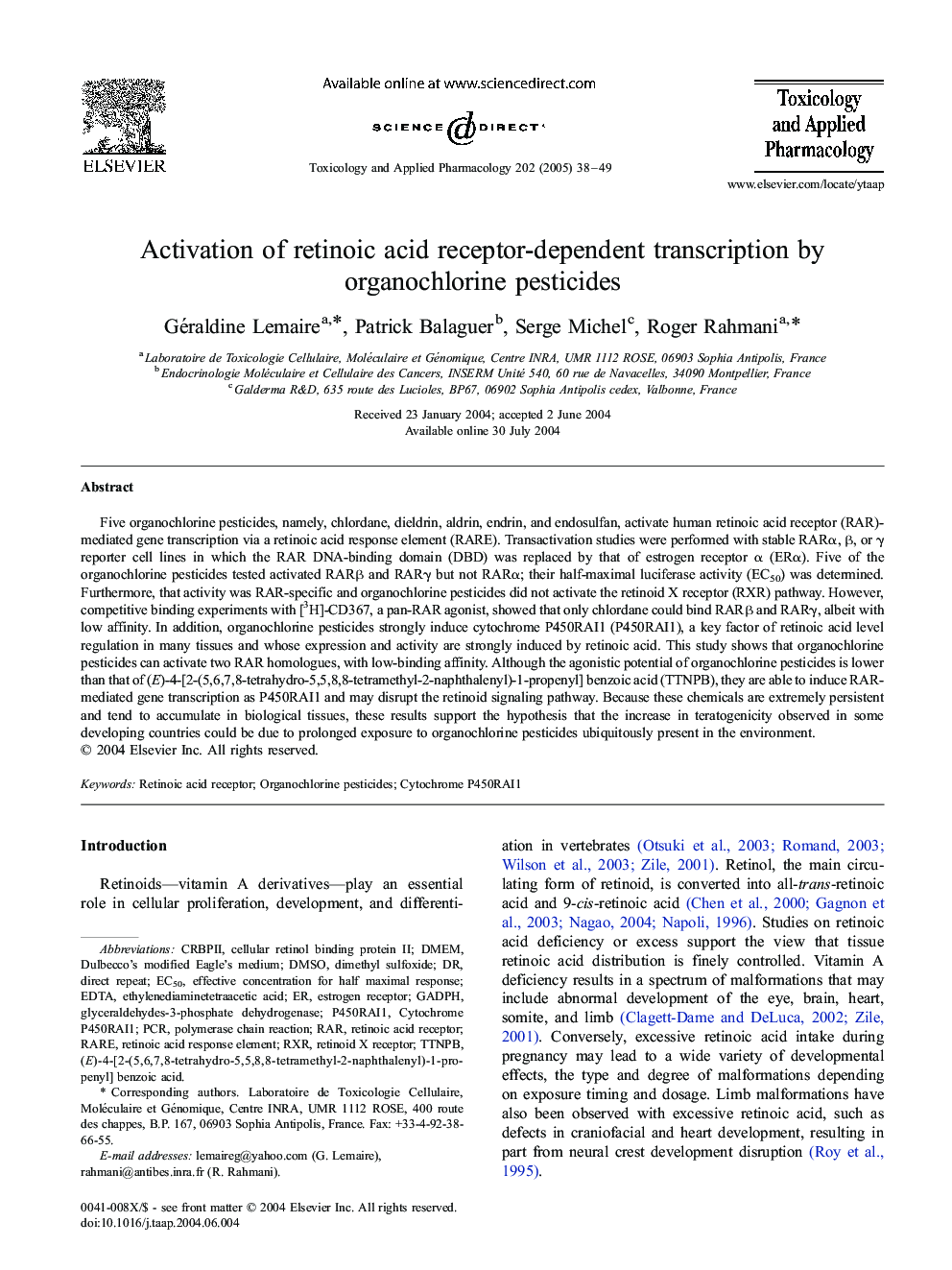| کد مقاله | کد نشریه | سال انتشار | مقاله انگلیسی | نسخه تمام متن |
|---|---|---|---|---|
| 9018151 | 1128690 | 2005 | 12 صفحه PDF | دانلود رایگان |
عنوان انگلیسی مقاله ISI
Activation of retinoic acid receptor-dependent transcription by organochlorine pesticides
دانلود مقاله + سفارش ترجمه
دانلود مقاله ISI انگلیسی
رایگان برای ایرانیان
کلمات کلیدی
TTNPBDMEMRXRRARRetinoid X receptorGADPHEC50CRBPIIDMSO - DMSODulbecco's modified Eagle's medium - Medal of Eagle اصلاح شده DulbeccoOrganochlorine pesticides - آفت کش های ارگانو کلرهEDTA - اتیلن دی آمین تترا استیک اسید Ethylenediaminetetraacetic acid - اتیلینیدامین تتراستیک اسیدdirect repeat - تکرار مستقیمDimethyl sulfoxide - دیمتیل سولفواکسیدretinoic acid response element - عنصر پاسخ رتینوئیک اسیدRARE - نادرpolymerase chain reaction - واکنش زنجیره ای پلیمرازPCR - واکنش زنجیرهٔ پلیمرازglyceraldehydes-3-phosphate dehydrogenase - گلیسرالید هیدروژن 3-فسفات دهیدروژنازEstrogen receptor - گیرنده استروژنRetinoic acid receptor - گیرنده اسید رتینوئیک
موضوعات مرتبط
علوم زیستی و بیوفناوری
علوم محیط زیست
بهداشت، سم شناسی و جهش زایی
پیش نمایش صفحه اول مقاله

چکیده انگلیسی
Five organochlorine pesticides, namely, chlordane, dieldrin, aldrin, endrin, and endosulfan, activate human retinoic acid receptor (RAR)-mediated gene transcription via a retinoic acid response element (RARE). Transactivation studies were performed with stable RARα, β, or γ reporter cell lines in which the RAR DNA-binding domain (DBD) was replaced by that of estrogen receptor α (ERα)?. Five of the organochlorine pesticides tested activated RARβ and RARγ but not RARα; their half-maximal luciferase activity (EC50) was determined. Furthermore, that activity was RAR-specific and organochlorine pesticides did not activate the retinoid X receptor (RXR) pathway. However, competitive binding experiments with [3H]-CD367, a pan-RAR agonist, showed that only chlordane could bind RARβ and RARγ, albeit with low affinity. In addition, organochlorine pesticides strongly induce cytochrome P450RAI1 (P450RAI1), a key factor of retinoic acid level regulation in many tissues and whose expression and activity are strongly induced by retinoic acid. This study shows that organochlorine pesticides can activate two RAR homologues, with low-binding affinity. Although the agonistic potential of organochlorine pesticides is lower than that of (E)-4-[2-(5,6,7,8-tetrahydro-5,5,8,8-tetramethyl-2-naphthalenyl)-1-propenyl] benzoic acid (TTNPB), they are able to induce RAR-mediated gene transcription as P450RAI1 and may disrupt the retinoid signaling pathway. Because these chemicals are extremely persistent and tend to accumulate in biological tissues, these results support the hypothesis that the increase in teratogenicity observed in some developing countries could be due to prolonged exposure to organochlorine pesticides ubiquitously present in the environment.
ناشر
Database: Elsevier - ScienceDirect (ساینس دایرکت)
Journal: Toxicology and Applied Pharmacology - Volume 202, Issue 1, 1 January 2005, Pages 38-49
Journal: Toxicology and Applied Pharmacology - Volume 202, Issue 1, 1 January 2005, Pages 38-49
نویسندگان
Géraldine Lemaire, Patrick Balaguer, Serge Michel, Roger Rahmani,